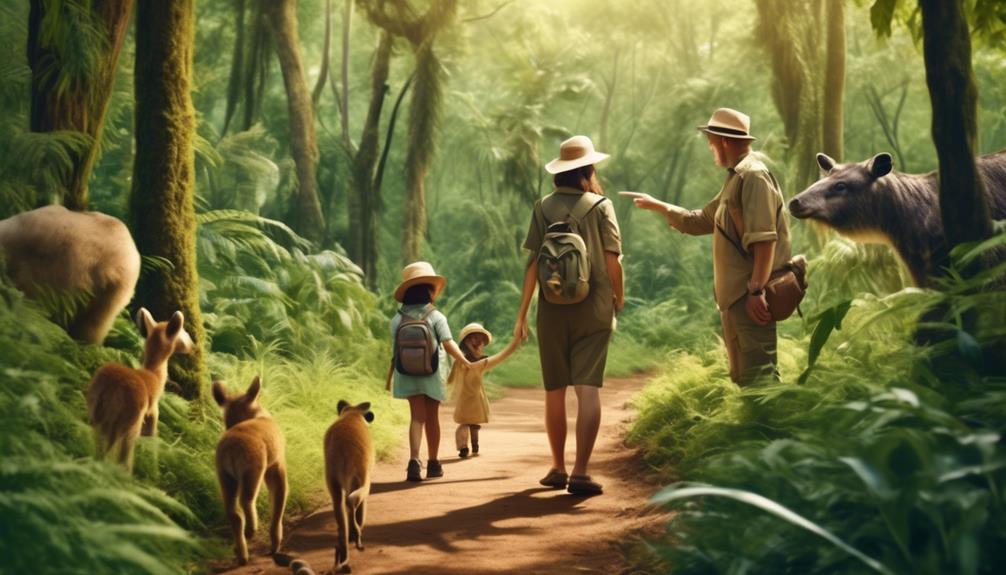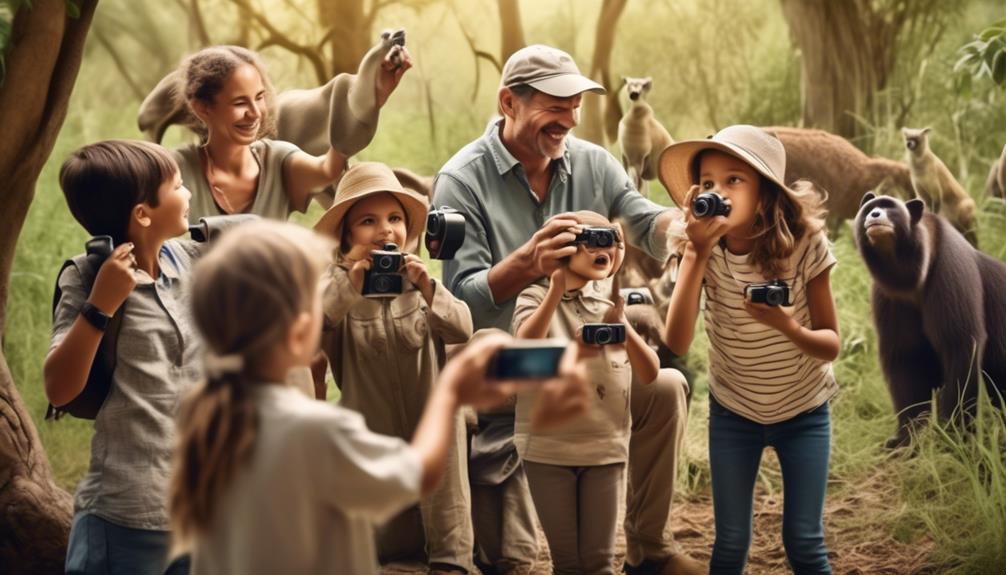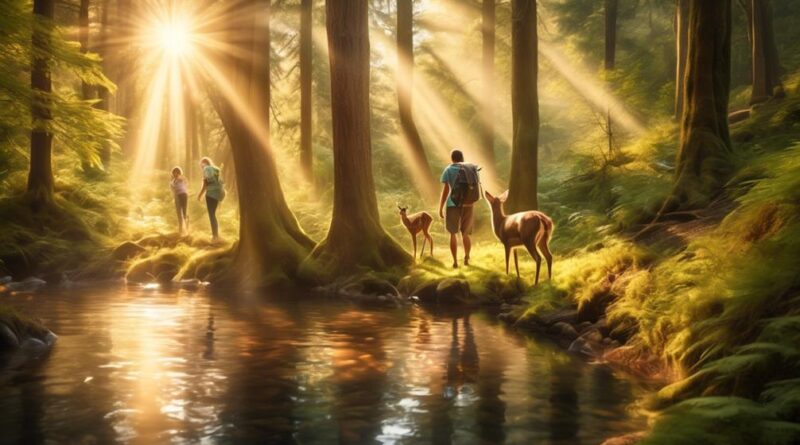How-to Guide: Family-Friendly Wildlife Encounter Adventures
Embarking on family-friendly wildlife encounter adventures can be a thrilling and transformative experience for both you and your loved ones. Whether you're seeking to spot soaring bald eagles, playful dolphins, or majestic elephants, the prospect of planning such an escapade can be both exhilarating and overwhelming.
But fear not, for this guide will equip you with practical tips and expert advice to ensure that your wildlife encounters are not only enjoyable but also safe and enriching.
So, are you ready to embark on an adventure that will create lasting memories for your family?
Selecting the Perfect Wildlife Destination

When choosing the perfect wildlife destination for your family adventure, consider the interests and preferences of each family member to ensure an enjoyable and memorable experience. Wildlife observation and nature exploration are key components of a family-friendly wildlife encounter adventure.
Start by identifying the specific wildlife that each family member is eager to see. For instance, if your kids are fascinated by marine life, a destination offering opportunities for snorkeling and dolphin watching would be ideal. If your partner is passionate about birdwatching, consider a location known for its diverse bird species. Taking everyone's interests into account ensures that each family member feels included and excited about the upcoming adventure.
Once you have identified the wildlife interests, consider the level of nature exploration that each family member is comfortable with. Some may be eager for immersive experiences such as guided jungle treks, while others may prefer more relaxed activities like wildlife safaris or boat tours. It's important to strike a balance that allows everyone to engage with nature at their own pace.
Look for destinations that offer a variety of activities, from leisurely nature walks to more adventurous wildlife encounters, ensuring that there's something for everyone to enjoy.
Planning Wildlife-Focused Activities
To plan wildlife-focused activities, consider the specific interests of each family member and seek out experiences that cater to those preferences. Researching wildlife-friendly accommodations is crucial. Look for lodges, resorts, or campgrounds that are situated near wildlife reserves, national parks, or wildlife hotspots. Check if the accommodations offer guided wildlife tours or have wildlife viewing areas on their premises. It's also important to pack essential wildlife gear. Binoculars, a camera with a good zoom lens, and a field guide for identifying animals and birds are must-haves. Additionally, consider packing insect repellent, sunscreen, and appropriate clothing and footwear for outdoor excursions.
When planning wildlife-focused activities, take into account the ages and physical abilities of all family members. Look for activities that are suitable for everyone. For instance, if there are young children or elderly family members, consider gentle nature walks or wildlife drives instead of strenuous hikes.
Furthermore, consider the time of year when planning wildlife-focused activities. Different seasons offer varying wildlife viewing opportunities. Some animals are more active during certain times of the year, and specific wildlife events, such as migrations or mating seasons, only occur at particular times. Research the best times to visit your chosen destination for optimal wildlife encounters.
Finding Family-Friendly Wildlife Tours

Consider exploring family-friendly wildlife tours that cater to the interests and ages of all family members, providing opportunities for engaging and educational wildlife encounters. When searching for wildlife tour operators, look for those that specifically advertise child-friendly wildlife encounters. These operators often have guides who are skilled at engaging children and explaining wildlife in a way that's both educational and entertaining. They may also offer activities tailored to younger participants, such as scavenger hunts, interactive presentations, or hands-on experiences with animal artifacts.
When researching potential tours, seek out reviews and testimonials from other families who've taken the tours. This can provide valuable insight into the experiences of families with children similar in age to yours. Additionally, consider reaching out directly to the tour operators to inquire about the specific activities and accommodations they offer for families with children.
It's important to find a tour that strikes a balance between being educational and entertaining, while also ensuring the safety and comfort of all family members. Some operators may provide specialized equipment or facilities for children, such as kid-sized binoculars or child-friendly viewing platforms. By choosing a tour that's designed with children in mind, you can ensure that the whole family will have a memorable and enjoyable wildlife experience.
Understanding Wildlife Safety Guidelines
Ensure you understand and adhere to wildlife safety guidelines to protect yourself and your family during wildlife encounters. When venturing into the wild, it's crucial to prioritize safety and respect for the animals. Here are some essential points to keep in mind:
- Respect their space: Wildlife encounter etiquette is essential for both your safety and the well-being of the animals. Always maintain a safe distance and avoid approaching or disturbing them. Remember, they're wild creatures and should be observed from a distance to avoid provoking any unwanted reactions.
- Stay aware of animal behavior: Being conscious of animal behavior awareness is crucial during wildlife encounters. Understanding their body language and signs of distress can help you anticipate their reactions and avoid potential dangers. Teach your family to recognize these signs and always remain vigilant.
- Follow park regulations: Whether you're exploring a national park or wildlife reserve, it's vital to adhere to the rules and regulations set by the authorities. These guidelines are in place to ensure the safety of visitors and the conservation of the wildlife. By following these regulations, you contribute to the preservation of the natural habitat.
Capturing Wildlife Moments With Photography

When venturing into the wild, prioritize safety and respect for the animals, while also capturing unforgettable wildlife moments with your photography. Wildlife photography provides a way to preserve the beauty of nature and share it with others.
To make the most of your wildlife photography adventure, start by understanding the behavior of the animals you want to photograph. This knowledge will help you anticipate their movements and capture more genuine moments. Remember to keep a safe distance from the animals and use a telephoto lens to avoid disturbing them. Patience is key in wildlife photography, so take your time and wait for the perfect shot.
In addition to capturing stunning images, wildlife photography also fosters a deeper appreciation for the natural world. As you focus on composing your shots, take a moment to soak in the beauty around you. Pay attention to the intricate details of the environment, from the delicate patterns of a bird's feathers to the subtle movements of a grazing deer. By immersing yourself in the process of capturing wildlife moments, you'll develop a greater reverence for the creatures and their habitats.
When photographing wildlife, strive to convey the animals' stories through your images. Capture their expressions, interactions, and behaviors to create compelling narratives that resonate with viewers. By combining your passion for photography with a deep appreciation for nature, you can create powerful and evocative wildlife photographs that inspire others to cherish and protect the natural world.
Engaging in Wildlife Conservation Efforts
To actively contribute to wildlife conservation efforts, there are several steps you can take.
First, participate in local habitat restoration projects and support organizations dedicated to protecting endangered species. These projects and organizations play a crucial role in preserving wildlife and their habitats.
Conservation education is also important in raising awareness about the importance of wildlife preservation. By educating yourself and others about conservation issues, you can inspire positive change within your community.
Additionally, consider volunteering your time at wildlife rehabilitation centers. This allows you to directly assist in the care and rehabilitation of injured or orphaned animals. Your involvement in these efforts not only aids in the recovery of wildlife but also fosters a deeper appreciation for the natural world.
Lastly, advocate for sustainable practices in your daily life and encourage others to do the same. Every small action, from reducing plastic use to choosing sustainable products, contributes to the larger goal of wildlife conservation.
Exploring Wildlife Habitats and Ecosystems

Engage with the natural world by immersing yourself in the exploration of diverse wildlife habitats and ecosystems, connecting directly with the environments you're working to preserve. Animal tracking is a thrilling way to gain insight into the behaviors and movements of various wildlife species. As you venture into the wild, keep a keen eye out for tracks, scat, and other signs of animal presence. By learning to interpret these clues, you can piece together a fascinating narrative of the creatures that inhabit the area, enhancing your understanding of their daily lives and interactions.
In addition to animal tracking, bird watching offers an opportunity to appreciate the diverse avian species that call different habitats home. From wetlands to forests, each ecosystem hosts a unique array of birds, each adapted to thrive in its specific environment. With binoculars in hand, you can observe the graceful flight patterns, distinct calls, and mesmerizing behaviors of these feathered inhabitants. Moreover, by familiarizing yourself with the birds in a particular area, you can gain valuable insights into the overall health and biodiversity of the ecosystem.
Exploring wildlife habitats and ecosystems not only provides an enriching experience for nature enthusiasts but also fosters a deeper connection to the environments we aim to protect. By delving into the intricacies of these habitats, you can gain a profound appreciation for the interwoven relationships between species and their surroundings, ultimately inspiring a greater commitment to conservation efforts.
Creating Lasting Memories With Wildlife Encounters
Immerse yourself in unforgettable wildlife encounters that will create lasting memories for you and your family. When engaging in wildlife encounters, it's important to remember wildlife etiquette. Always respect the animals and their habitats by keeping a safe distance, not feeding them, and following any guidelines provided by park rangers or tour guides. By doing so, you'll have a more authentic and respectful experience with the wildlife, allowing for a deeper connection and understanding of the natural world.
Another crucial aspect of creating lasting memories with wildlife encounters is to observe and learn about animal behavior. Take the time to watch how animals interact with each other and their environment. Notice the unique personalities and habits of different species, and encourage your family to ask questions and engage in discussions about what they observe. This not only enhances the experience but also fosters a deeper appreciation for the intricacies of the animal kingdom.
Lastly, capture the moments. Bring a camera or smartphone to document the wildlife encounters. Whether it's a stunning landscape, a playful animal, or a rare sighting, photographs and videos can serve as powerful reminders of the incredible experiences you shared with your loved ones. These visual mementos will allow you to relive the memories and share them with others, preserving the magic of your wildlife encounters for years to come.
Frequently Asked Questions
How Can I Prepare My Children for Their First Wildlife Encounter Adventure?
To prepare your children for their first wildlife encounter adventure, start by discussing nature exploration and sensory activities. Teach them animal behavior and observation techniques. Encourage curiosity and respect for the natural world to enhance their experience.
What Are Some Tips for Keeping Young Children Engaged and Interested During Wildlife Tours?
To keep young children engaged during wildlife tours, try nature scavenger hunts and interactive learning. Get them involved with wildlife photography and hands-on activities. Encourage curiosity and exploration to make the experience memorable and educational.
Are There Any Specific Safety Guidelines for Encountering Wildlife With Infants or Toddlers?
When encountering wildlife with infants or toddlers, prioritize their safety. Always maintain a safe distance from animals, and never leave children unattended. Teach them to observe without approaching, and be aware of any potential risks during wildlife interactions.
What Are Some Ways to Involve My Family in Wildlife Conservation Efforts During Our Adventures?
To involve your family in wildlife conservation during adventures, engage in family-friendly activities like nature hikes, beach cleanups, and tree planting. Teach children about wildlife safety, and create educational experiences that promote awareness and respect for nature.
How Can I Ensure That My Family's Wildlife Encounters Are Educational and Impactful for My Children?
To ensure that your family's wildlife encounters are educational and impactful for your children, prioritize wildlife observation and nature appreciation. Engage them in understanding animal behavior, fostering their love for nature and wildlife conservation.
Conclusion
You've now learned the ins and outs of planning a family-friendly wildlife encounter adventure. From selecting the perfect destination to engaging in conservation efforts, there are so many ways to make lasting memories with your loved ones.
Remember to always prioritize safety and respect for the animals and their habitats. With these tips in mind, you're ready to embark on an unforgettable wildlife adventure with your family.
Enjoy the journey!
